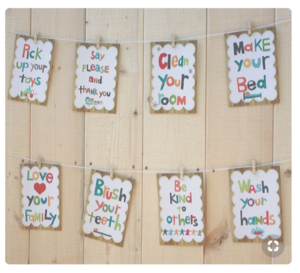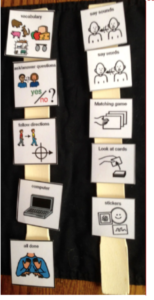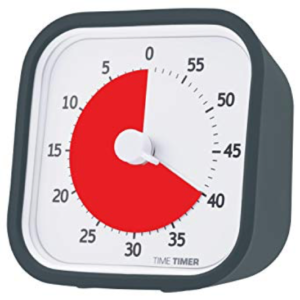
Psychosocial health (also called “mental health”) includes behavior, emotional adjustment, learning/school success, and relationships. These things are very important for overall well-being and quality of life. Addressing the psychosocial needs of a person with Duchenne is an important part of your child’s medical care.
In this three-part blog series on Behavior Challenges and Duchenne, we have consulted with Denise Gruender, owner of ABC Educational Services, Matthews, N.C., to introduce three different behavior topics (encouraging positive behavior, establishing consequences, and resources to help you) to give you suggestions and tools that we hope will help you along the journey of parenting. Denise is has over 20 years of experience working with children, to include creating an amazing school for children on the spectrum, enabling their successful integration into the public-school environment.
Please note – This blog series is meant to provide simple suggestions for parents to try – especially parents who may be facing a new diagnosis or witnessing behavior issues in their child with Duchenne for the first time. These suggestions may not be appropriate for all children, especially those who may be a little older or those with more severe issues. We encourage you to explore the Learning & Behavior area of PPMD’s website for additional information, and consult with a qualified medical professional who can assess your child and suggest treatment options.
BEHAVIOR CHALLENGES AND DUCHENNE BLOG SERIES:
Part 1 – Encouraging Positive Behavior
I think all of us can relate to terms such as the ‘terrible 2s’, the ‘trying 3s’, the ‘questioning 4s’ and on, because at every age, children go through periods of challenging behaviors. Some of these behaviors may include angry outbursts, inflexible thinking, and/or impulsive behaviors which are difficult for parents to deal with.
Children with Duchenne are no exception. Parenting your child(ren) with Duchenne is tough because it is difficult to see them as a ‘normal’ child when we tend to look at everything through the lens of the diagnosis. We have all experienced thoughts like, “I shouldn’t let him do that, but he has Duchenne”, and it just feels like you should give in to whatever behavior is occurring. And it is hard to be ‘tough’ when your heart is breaking.
What you must remember is that your child is the same child that you had before the word Duchenne entered your vocabulary. One of the most difficult things to do is to treat this child the same way you treat your other children, and the same way you treated this child before the diagnosis. You are the parent and families need rules. Without rules and acceptable behaviors, the entire family will struggle.
Establishing Rules
Children want limits, and they will push and push until they figure out where your limits are. Making rules and following them will help the child know what is appropriate and what is not. Every time the child does something that is not appropriate, make a rule about it and do it immediately after the behavior happens. Write it on the ‘RULE WALL’ so that everyone in the family follows the rule (see more on the RULE WALL below). Rules help take the guess work out of just how far the child can push.
Following Through
One of the hardest parts of parenting is disciplining – sticking to the rules and following through. Sometimes we find ourselves making a quick statement out of frustration, ‘we are never going to have ice cream again’ or ‘we are never going out again’, statements that are not accurate, made when you are pushed to the edge. Children do tend to push your buttons to see just how far they are able to push the rules and you will often find it is difficult to be strong. Parents often say, “I shouldn’t let him talk to me that way, but I’m sure he is frustrated” or “It hurts my feelings when he yells at me, but using his voice is my son’s only way of controlling his world.”
In the short term, giving in may make your child happy and may avoid angry discussions, but, in the long term, it’s hard to live with a child who’s always been given into and who is allowed to treat the people around him in any manner he chooses. And if the child does not learn ‘NO’ at home, they will never accept rules outside the home. Unacceptable behaviors will make school and friendships ever more challenging.
Recommended Tools
Parenting is one of the most rewarding, yet challenging things we tackle in our lives. Add in Duchenne, and it can seem nearly impossible. Unfortunately there is no instruction manual. What we do have are some useful tools other parents and experts have recommended that may be helpful for you and your partner. These are ideas that start everyone in the family on a level playing field, with rules that don’t play favorites – something particularly important for the siblings of a child with Duchenne, when the household can feel like it rotates around doctor appointments and other accommodations.
RULE WALL
Every home needs a RULE WALL. This is a list of what behavior is acceptable at home and what is not. The RULE WALL should be visible to everyone. Rules are added over time as situations arise, and they apply to ALL members of the family. And, while it may seem silly, this is an agreed upon set of accepted behaviors that the family lives by.
Always start with positive rules and here are some examples:
- We leave the playground with a HAPPY FACE if given a 5 minute warning
- We take a bath and wash hair without crying
- We eat 6 bites of the meal before we are allowed dessert
Every family will have their own rules that make the most sense for them. Part of the success of a RULE WALL comes from the parents being held accountable as well!
Here are two examples of what a rule wall might look like at home and/or at school:

 SCHEDULE STICK
SCHEDULE STICK
Another important tool is a schedule in writing about a child’s day. This helps to alleviate frustration for the child as he/she understands the schedule and what happens when. You and your child might consider creating a SCHEDULE STICK together. The Schedule Stick is an outline of the activities of the day. This makes transitions from one activity to another easier.

We will be making SCHEDULE STICKS on some of our upcoming End Duchenne Tour stops. Learn about our upcoming dates!
VISUAL TIMER
A VISUAL TIMER shows the child how long a given task will take and helps the child anticipate the time involved in specific tasks. Example: ‘taking a bath will take x minutes’ or ‘watching TV for 30 min’ or ‘getting a haircut will take xx minutes.’
Helping your child grasp the concept of time will help them understand when that time has run out. It doesn’t mean that they’ll like it, but at least it makes something like ‘five more minutes’ easier to grasp!

Next in this Series
In our next blog post, we’ll discuss methods of managing behavior with positive consequences.
Share Your Data
Your journey can help tell the story of psychosocial health in Duchenne and increase the understanding of experts in the field. That’s why we are asking you to update your Behavior & Learning Module in The Duchenne Registry. Log into your Registry account, go to your Dashboard, and click “Start Survey” next to the Behavior & Learning Module. If you completed the survey more than a year ago, click “Update Survey” to update your answers.
Not in the Registry? Join today and your data will help fuel the fight to end Duchenne.



 by: Parent Project Muscular Dystrophy
by: Parent Project Muscular Dystrophy

